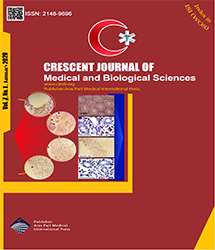
| Original Article | |
| Effects of Electrocauterization Smoke on Nasal Mucosa in Rats | |
| Hoda Khoshdel Sarkarizi1, Ramin Salimnejad2, Amir Hosein Jafarian3, Masoumeh Fani1, Nasim Khajavian4, Esmail Nourmohamadi5, Ghasem Sazegar1 | |
| 1Department of Anatomical Sciences and Cell Biology, Faculty of Medicine, Mashhad University of Medical Sciences, Mashhad, Iran 2Research Laboratory for Embryology and Stem Cells, Department of Anatomical Sciences and Pathology, School of Medicine, Ardabil University of Medical Sciences, Ardabil, Iran 3Department of Pathology, Ghaem Hospital, Mashhad University of Medical Sciences, Mashhad, Iran 4Department of Biostatistics and Epidemiology, Faculty of Health, Mashhad University of Medical Sciences, Mashhad, Iran 5Department of Medical Biotechnology, Faculty of Medicine, Mashhad University of Medical Sciences, Mashhad, Iran |
|
|
CJMB 2020; 7: 34–39 Viewed : 6522 times Downloaded : 3455 times. Keywords : Electrocauterization smoke, Complication, Nasal mucosa, Rat |
|
| Full Text(PDF) | Related Articles | |
| Abstract | |
Objectives: Electrocautery unite is used for vascular homeostasis. Despite the advantage of electrocautery in surgical interventions, it has several disadvantages such as pulmonary respiratory disorders, emphysema, bronchitis, and asthma. Given the above-mentioned explanation, the present study investigated the effects of electrocauterization smoke on rat nasal mucosa. Materials and Methods: Fifteen Wistar rats were divided into 3 groups (n=5) for three-time phases. Smoke was produced by the electrocauterization of an anesthetized rat within the smoke chamber and then smoke was entered into the test chamber containing the experimental rats. Finally, rats were anesthetized and the nasal mucosa was dissected under a stereomicroscope. After Hematoxylin and Eosin staining, the samples were impartially evaluated by a pathologist, followed by comparing the frequency of complications between different groups. Eventually, the TUNEL (The terminal deoxynucleotidyl transferase dUTP nick end labeling) technique was utilized to investigate the apoptosis. Results: Pathological studies showed complications such as vascular congestion, epithelial vacuolation, acute inflammation, and the presence of necrotic cells. In addition, statistical analysis indicated that the rate of vascular congestion, acute inflammation, and inflammation in glands in the second and third phases of the study signifcantly increased compared to the control group. Further, the difference between the experimental groups was only signifcant when the frst phase was compared with the second (P<0.05). However, the rate of epithelial vacuolation and the presence of necrotic cells demonstrated no signifcant increase in comparison to the control group. Contrarily, the numerical density of apoptotic cells signifcantly increased within the respiratory epithelium and submucosal glands of experimental rats (P<0.05). Conclusions: The results of this study indicated that short-term exposure to electrocauterization smoke has no specifc effect, but longer duration of smoke exposure can damage the rat nasal mucosa. |
Cite By, Google Scholar
Google Scholar
PubMed
Online Submission System
 CJMB ENDNOTE ® Style
CJMB ENDNOTE ® Style
 Tutorials
Tutorials
 Publication Charge
Medical and Biological Research Center
About Journal
Publication Charge
Medical and Biological Research Center
About Journal
Aras Part Medical International Press Editor-in-Chief
Arash Khaki
Deputy Editor
Zafer Akan


















